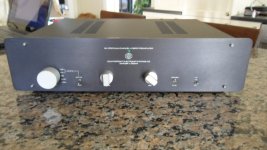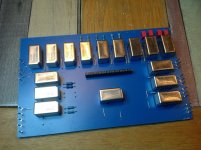In my mind it is completely absurd bordering criminal that a switching device does not exist which can handle multiple (let’s say anything more than 2) TTs, any input either stepped up for MC or pass through for mm and even *gasp* handle both C and R loading.
There’s about 5 gazillion tonearms, TTs and cartridges out there. One would think some people have more than one of each and want some degree of versatility for fiddling?
Every time I see this topic come up it usually gets shut down with a variety of canned reasons from “you don’t need that really” to “beginners mistake” to “it’s too preciously low of a signal to mess with like that”
Surely the great minds here could surmount the technical obstacles without audible degradation? I’d even trade some minor degradation for less battling the sea of wires tucked behind my credenza.
Personally I think it could be a giant conspiracy against us Bill, but that’s just me ;-)
Either way I’ll be following with interest.
Only ones I’m aware of currently are the boxes by David Hadaway of dB systems... spartan looking to say the least and it’s a multi-box affair. The switches don’t use relays- all rotary.
There’s about 5 gazillion tonearms, TTs and cartridges out there. One would think some people have more than one of each and want some degree of versatility for fiddling?
Every time I see this topic come up it usually gets shut down with a variety of canned reasons from “you don’t need that really” to “beginners mistake” to “it’s too preciously low of a signal to mess with like that”
Surely the great minds here could surmount the technical obstacles without audible degradation? I’d even trade some minor degradation for less battling the sea of wires tucked behind my credenza.
Personally I think it could be a giant conspiracy against us Bill, but that’s just me ;-)
Either way I’ll be following with interest.
Only ones I’m aware of currently are the boxes by David Hadaway of dB systems... spartan looking to say the least and it’s a multi-box affair. The switches don’t use relays- all rotary.
Last edited:
In my mind it is completely absurd bordering criminal that a switching device does not exist which can handle multiple (let’s say anything more than 2) TTs, any input either stepped up for MC or pass through for mm and even *gasp* handle both C and R loading.
Perhaps there is not a large enough market for a standalone device?
The Devialet amplifiers (well, their Expert series) allow for switching on-the-fly assignment of inputs and remote selection of, at the very least (1) amplification level, (2) C loading, (3) R loading and (4) compensation curve.
During play, from the remote.
So it is possible, and it does not degrade the sound, not to these ears.
Space: I'm guilty in the past of relay angst and using rotary switches. I am trying a different direction this time partly because I'm fed up with the wiring rats nest rotaries cause and the fact that some things you just can't easily do with switches.
The whole assembly and ADC is going to end up in the attached. The existing board is beyond redemption. Just not a good design, but the box is good and has WAF. If I lose the balance function I have just enough controls without drilling more holes in the front panel. BUT Can only be done with relays or equivalent and maintain my sanity .
.
The whole assembly and ADC is going to end up in the attached. The existing board is beyond redemption. Just not a good design, but the box is good and has WAF. If I lose the balance function I have just enough controls without drilling more holes in the front panel. BUT Can only be done with relays or equivalent and maintain my sanity
Attachments
Those big power switches are for POWER. The contact alloy will tarnish, but 240V 20A will blow-through the tarnish. They would not be first-choice for small audio.
However you can get them exceptionally low-price through Amazon, eBay, and direct from Asian web-shops, so would cost little to try.
However you can get them exceptionally low-price through Amazon, eBay, and direct from Asian web-shops, so would cost little to try.
Read relays have magnetic contacts - lot of distortion and no go for audio
B.S.
There are many relays and switches that are not suitable for switching low level audio, IMLE reed relays are amongst the most suitable choices with long lived hermetically sealed contacts of the appropriate metallurgical qualities for the task. You of course have to purchase the correct one.
Magnetic contacts, lots of distortion, what else have we missed.
I wonder that a small Relay can be criticized to such a degree.
What about the contacts on the Cart itself, neighbouring to very strong magnets.
And what about all the Cinch or Din connectors in the line.
The whole matter is grossly overestimated, and every gold-plated miniature relay or the somewhat larger reed relay can do a perfect job.
Hans
I wonder that a small Relay can be criticized to such a degree.
What about the contacts on the Cart itself, neighbouring to very strong magnets.
And what about all the Cinch or Din connectors in the line.
The whole matter is grossly overestimated, and every gold-plated miniature relay or the somewhat larger reed relay can do a perfect job.
Hans
Indeed it was for power switch. I was thinking more in the line as below....Those big power switches are for POWER. The contact alloy will tarnish, but 240V 20A will blow-through the tarnish. They would not be first-choice for small audio.
However you can get them exceptionally low-price through Amazon, eBay, and direct from Asian web-shops, so would cost little to try.
Both turntable and both phono preamplifier will be connected to amplifier. (Kind of parallel signal out from both preamp to single amplifier) However the preamplifiers will obviously have two power supplies and with the switch I mentioned will only have option to turn on any SINGLE phono preamplifier. No chance of turning both, so other switched off preamplifier will not be sending any signal to MAIN amplifier. This way one has solid connections of Interconnect cables. Will that work ?
Regards
Generally not good practice to have unpowered circuits hanging in parallel with powered ones. I would not consider that as an option. Once you have gone through the phono pre you will be in the 0.5v range so any relay will do the job fine. Before as several people have mentioned, it's a case of picking the right relay.
What I found is that reed relays are more than 10 times as expensive as for instance the miniature dpdt IM relays from TE connectivity costing less than € 2,- from Farnell.
Both can be operated over more than 1Mio times, some reed relays even over 100 Mio times, but I don’t expect Bill going to switch that often.
Hans
Both can be operated over more than 1Mio times, some reed relays even over 100 Mio times, but I don’t expect Bill going to switch that often.
Hans
OK. Got that.Generally not good practice to have unpowered circuits hanging in parallel with powered ones. I would not consider that as an option. Once you have gone through the phono pre you will be in the 0.5v range so any relay will do the job fine. Before as several people have mentioned, it's a case of picking the right relay.
Regards.
Magnetic contacts, lots of distortion, what else have we missed.
I wonder that a small Relay can be criticized to such a degree.
What about the contacts on the Cart itself, neighbouring to very strong magnets.
And what about all the Cinch or Din connectors in the line.
The whole matter is grossly overestimated, and every gold-plated miniature relay or the somewhat larger reed relay can do a perfect job.
There are two types of relays: reed relays, in which the signal passes through a magnetically permeable reed, and 'armature' relays, in which a magnetic motor moves an armature and contacts, which carries the signal but is not ferromagnetic. It is not logically sound to confuse the two with each other.
Gold is never used on reed relays, since it is too soft, and reed relays can be made hermetic, with only the contacts inside of the glass envelope, This allows the use of platinum type contacts such as palladium or ruthenium, metals which are electrically and mechanically preferable to gold, but behave very poorly when exposed to organic substances from the air, or polymer vapors from its own coil varnish or plastic housing, as in a non-hermetic armature relay.
So, if you find that gold contact relays do not have this problem, then you're right - they're armature relays, not reed relays, so they do not pass the signal through magnetically soft materials. Two completely different technologies. Passing an AC current through a magnetically soft conductor can distort the AC signal from the field created by the signal current acting upon the magnetically permeable conductor itself. It's not a static field that causes problems, like that from magnets inside of a phono cartridge, but the signal induced magnetic field acting on the magnetically soft conductor that causes problems. Passing the signal through a non-magnetic armature of beryllium copper for example will not have these problems at all.
This effect depends on the magnitude of the current as well. With low phono cartridge currents, this effect will probably not be a problem. However, not all switching tasks are extremely low current. So, that too needs to be taken into account.
If you want a good armature relay, the Teledyne 712 is a fine hermetic, gold over silver contact DPDT relay. They're pricey, but small, and perform well. Why gold in a hermetic relay? The actuating coil, insulated with polymers, is inside of the hermetic case, so any polymer vapors emitted from the heated coil cannot be exposed to a platinum type contact like Pd or Ru, or they turn into a carbon gunk that destroys the contacts. They draw about 3/8W per coil, and switch rapidly and reliably. It's a DPDT switch too, so only one coil does the equivalent of four reed relays, simplifying logic and making them more cost competitive (or maybe 'not quite as outrageously priced'). A fine choice for any line level switching need.
+1 to Kevin in #46
Were you with the big “T” in Boston?
I worked for Practical Engineering and after that gig did a few years at the big T aka Teradyne..
In general I agree with Monte's comments, the current levels present in this application IMLE will not likely result in meaningful or measurable degradations in waveform fidelity.
His recommendation of the teledyne relay is a good one, to which I can add certain families of Panasonic relays as well.
His point about the metallurgy is an important one. The other important thing is purchase relays that are intended for switching low currents, I learned this the hard way with a relay that otherwise seemed highly suitable.
His recommendation of the teledyne relay is a good one, to which I can add certain families of Panasonic relays as well.
His point about the metallurgy is an important one. The other important thing is purchase relays that are intended for switching low currents, I learned this the hard way with a relay that otherwise seemed highly suitable.
- Status
- This old topic is closed. If you want to reopen this topic, contact a moderator using the "Report Post" button.
- Home
- Source & Line
- Analogue Source
- Phono switching with relays.



